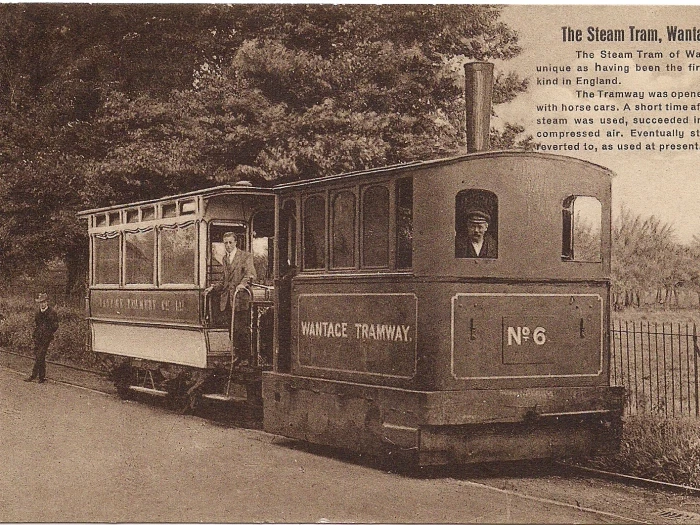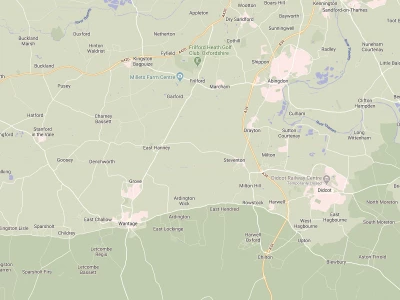Wantage Tramway
Wantage Tramway
By Didcot Railway Centre, read by Jim Birch
As this is a longer piece about the tramway in Wantage, the recording is split into two parts. The first is about the tramway's founding to 1925, and the number 5 engine. The second is about the tramway from 1925 onwards.
The first recording can be heard here: Wantage tramway and number 5
The second recording can be heard here: Wantage tramway 1925 onwards
More information about the tramway in Wantage can be found here: Tramway in Wantage
More information about the number 5 engine can be found here: Didcot Railway Centre engine 5
The full text is as follows:
Hi, I’m Jim Birch. I’ve lived around Wantage for over 40 years and I want to tell you a bit about the tramway that was in Wantage until 1945. The information is from the Vale and Downland Museum, and Didcot Railway Centre, websites. More information about the tramway in Wantage can be found from these museums. The tramway office can still be seen on Mill Street (look for the blue plaque on the wall!).
The Wantage Tramway was opened in October 1875 to carry passengers and goods
between Wantage and Wantage Road Station on the Great Western Railway, and, except
for a short break during the 1939-45 war, was in operation for 70 years. At first, horses were used as motive power, but steam was rapidly introduced and Wantage Tramway became the first tramway in Britain to operate a passenger service by means of steam traction.
The Wantage Tramway Company (W.T.C.) was established in 1873 to transport passengers and goods from the GWR (Great Western Railway) station, Wantage Road, to the town of Wantage itself which was about 2½ miles from the station. The old trick of stating that a station was sort of near a place it was supposed to serve by adding the word ‘Road’ afterwards was common practice in those days and could mean a long walk for the uninformed!
The line was built to standard gauge (4 feet 8½ inches or 1,435mm) as it was built after the gauge commission decreed that no new lines could be built to the GWR's broad gauge (7 feet 0¼ inch or 2,140mm). The line opened in 1875 and started at Wantage Road station on the Didcot to Swindon section of the GWR main line. Here there was a passenger siding and eventually a connection to the goods yard of the GWR. It then followed what is now the A338 (which was called the Besselsleigh Turnpike back in the day). There were two halts (a slightly raised mound of earth) – one at Oxford Lane and another at Grove Bridge. There were also five passing loops including one at Gypsy Lane and another where it met the Wilts and Berks Canal. The two sidings en-route were mainly used for dropping off wagons. When the passenger service was in operation, there were times when trains would cross; at these times, the passenger train was usually put into the sidings to allow the goods train to go past without stopping.
The Wantage Tramway was unique in that it was the only non-city tram scheme that made a profit from the beginning to end of its operations. It was, however, built neither for comfort nor speed and was often the butt of jokes with its fleet of second-hand vehicles. Originally, its horsepower was exactly that – horses! The wagons were moved from place to place by horses. It was initially a place that welcomed experimentation using both a steam powered tram designed and built by engineer John Grantham and a less successful pair of pneumatically powered tram cars designed by a Polish Frenchman by the name of Louis Mékarski.
Afterwards it became synonymous with the use of old railway equipment. Its passenger coaches were converted trams. Goods wagons were more often than not the ones delivered to them by the GWR and the locomotives were a really motley crew of different types. Numbers 1, 2, 4 and 6 were tram engines, number 7 was a Manning and Wardle 0-4-0 saddle tank that came from the Manchester ship canal. There’s very little information about number 3.
The number 5 engine was a small 0-4-0 well-tank engine dating from 1857 which was built at a cost of £800 by George England & Co. of New Cross, London, for Captain William Peel, R.N., owner of the Sandy and Potton Railway in Bedfordshire. Captain Peel gave his engine the name Shannon, after a frigate which he commanded on a voyage to the Far East in the year when the engine was built. In 1862 his railway was absorbed into the London and North Western Railway, and Shannon was engaged in shunting duties for the latter at Crewe when purchased for the tramway in 1878. Although officially known as Engine No. 5 in the tramway records, the little engine was soon christened Jane by local residents, and many Wantage people know No. 5 by that name to this day. When the tramway purchased No. 5, she steamed all the way from Crewe to Wantage. Quite an achievement for such a small locomotive!
88888888
In 1925, the tramway company decided to close its passenger service. This decision was
influenced by the introduction of an omnibus service by the Great Western Railway which
included the route between Wantage Road and the town. Engine No. 5, and another engine, No. 7, were retained for hauling goods and the tramway quickly assumed the role of a mineral line, that is, a railway line that is purely used for transporting goods. The track and the remaining rolling stock gradually deteriorated over the next two decades and the tramway was finally forced to close on 21st December 1945, just over 70 years after the first horse-drawn trip of October 1875.
A short time later, when the tramway's rolling stock was put up for sale, a tender of £100
for No. 5 was accepted from the General Manager of the Great Western Railway who said
that the GWR wished to preserve the engine because of the long association between the
tramway, the town of Wantage and the railway company. Bearing the name Shannon once more, No. 5 was mounted in an enclosure on the down platform of Wantage Road Station in April 1948, and would presumably have stayed there indefinitely had the station not been closed under the Beeching cuts in 1965.
Over the next few years work on renovating the George England engine continued;
eventually it was repainted and once again given the number W.T.C. No. 5. During this
period No. 5 was in steam on several occasions. On 31st August 1975 the engine was in
the Grand Steam Cavalcade to celebrate the 150th anniversary of the Stockton and
Darlington Railway. Thirty-five locomotives took part in the run from Shildon to
Heightington, Co. Durham, and at the age of 118, No. 5 was the veteran of the show.
Now 125 years old, No. 5 will be conserved in the condition that she is kept at now at Didcot Railway Centre. No. 5 is also the last substantial relic Of the Wantage Tramway Company, a concern remembered with affection by older residents of Wantage who still refer to Shannon, alias No. 5, as Jane.
One of the most famous stories about the Wantage Tramway took place in 1923 and involved a man called Arthur, a donkey and an engine. Arthur Hitchcock (who was born in 1863 and moved to Grove in 1880) worked on the Great Western Railway until he lost his leg in an accident. He then became a chimneysweep, travelling to work by donkey and cart. One day in 1934, when Arthur was on his way home from a job in Hanney, Jim the donkey was pulling him along Station Road (near the tramway) when a Wantage-bound tram came up behind him and spooked him. The donkey bolted and far outstripped the tram on his way home. The ‘race’ is still remembered to this day in picture form (an artist from London was on the tram at the time) and in poetry, which many residents of Wantage and Grove can still quote to this day:
A curious race has come to pass
Between an engine and an ass;
The Wantage tram, all steam and smoke,
Was beat by Arthur Hitchcock's Moke.


